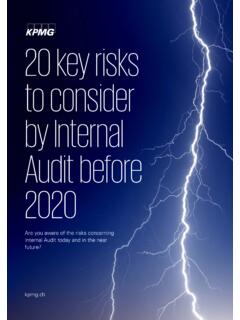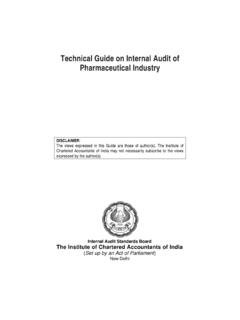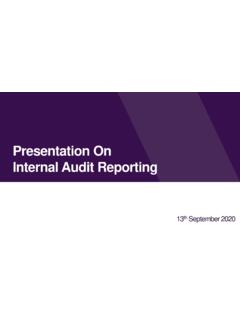Transcription of Public Sector Internal Audit Standards
1 Public Sector Internal Audit StandardsApplying the IIA International Standards to the UK Public SectorIssued by the Relevant Internal Audit Standard Setters:In collaboration with:Applying the IIA International Standards to the UK Public SectorPublic Sector Internal Audit StandardsUpdated March 2017 ISBN 978-1-84508-481-3 Permission has been obtained from the copyright holder, The Institute of Internal Auditors, 247 Maitland Ave, Altamonte Springs, Florida 32701-4201, USA. The concepts enunciated in the original IPPF have been preserved in this version. ContentsSection 1 Introduction 4 Section 2 Applicability 7 Section 3 Mission of Internal Audit 9 Section 4 Definition of Internal Auditing 10 Section 5 Core Principles for the Professional Practice of Internal Auditing 11 Section 6 Code of Ethics 12 Section 7 Standards 15 Attribute Standards 15 Purpose.
2 Authority and responsibility 15 Independence and objectivity 16 Proficiency and due professional care 18 Quality assurance and improvement programme 20 Performance Standards 23 Managing the Internal Audit activity 23 Nature of work 25 Engagement planning 27 Performing the engagement 29 Communicating results 30 Monitoring progress 33 Communicating the acceptance of risks 33 Glossary 34 Public Sector Internal Audit Standards 3 SECTION 1 IntroductionA professional, independent and objective Internal Audit service is one of the key elements of good governance, as recognised throughout the UK Public document is therefore addressed to accounting officers, accountable officers, board and Audit committee members, heads of Internal Audit , Internal auditors, external auditors and other stakeholders such as chief financial officers and chief overviewThe Relevant Internal Audit Standard Setters (RIASS)1 have adopted this common set of Public Sector Internal Audit Standards (PSIAS) from 1 April 2017.
3 The PSIAS encompass the mandatory elements of the Institute of Internal Auditors (IIA) International Professional Practices Framework (IPPF) as follows: Definition of Internal Auditing Code of Ethics, and International Standards for the Professional Practice of Internal Auditing (including interpretations and glossary).Additional requirements and interpretations for the UK Public Sector have been inserted in such a way as to preserve the integrity of the text of the mandatory elements of the overarching principle borne in mind when all potential Public Sector interpretations and/or specific requirements were considered was that only the minimum number of additions should be made to the existing IIA Standards . The criteria against which potential Public Sector requirements were judged for inclusion were: where interpretation is required in order to achieve consistent application in the UK Public Sector where the issue is not addressed or not addressed adequately by the current IIA Standards , or where the IIA standard would be inappropriate or impractical in the context of Public Sector governance (taking into account, for example, any funding mechanisms, specific legislation etc).
4 At the same time, the following concepts were also considered of each requirement or interpretation being proposed: materiality relevance necessity, and integrity (the additional commentary does not cause inconsistency elsewhere).1 The Relevant Internal Audit Standard Setters are: HM Treasury in respect of central government; the Scottish Government, the Department of Finance Northern Ireland and the Welsh Government in respect of central government and the health Sector in their administrations; the Department of Health in respect of the health Sector in England (excluding Foundation Trusts); and the Chartered Institute of Public Finance and Accountancy in respect of local government across the Public Sector Internal Audit StandardsWherever reference is made to the International Standards for the Professional Practice of Internal Auditing, this is replaced by the PSIAS.
5 Chief Audit executives are expected to report conformance on the PSIAS in their annual of the PSIASThe objectives of the PSIAS are to: define the nature of Internal auditing within the UK Public Sector set basic principles for carrying out Internal Audit in the UK Public Sector establish a framework for providing Internal Audit services, which add value to the organisation, leading to improved organisational processes and operations, and establish the basis for the evaluation of Internal Audit performance and to drive improvement guidance is a matter for the PSIAS apply to all Internal Audit service providers, whether in-house, shared services or Internal Audit assurance and consulting services fall within the scope of the Definition of Internal Auditing (see section 3). The provision of assurance services is the primary role for Internal Audit in the UK Public Sector .
6 This role requires the chief Audit executive to provide an annual Internal Audit opinion based on an objective assessment of the framework of governance, risk management and control. Consulting services are advisory in nature and are generally performed at the specific request of theorganisation, with the aim of improving governance, risk management and control and contributing to the overall Code of Ethics promotes an ethical, professional culture (see section 4). It does not supersede or replace Internal auditors own professional bodies Codes of Ethics or those of employing organisations. Internal auditors must also have regard to the Committee on Standards of Public Life s Seven Principles of Public common with the IIA IPPF on which they are based, the PSIAS comprise Attribute and Performance Standards . The Attribute Standards address the characteristics of organisations and parties performing Internal Audit activities.
7 The Performance Standards describe the nature of Internal Audit activities and provide quality criteria against which the performance of these services can be evaluated. While the Attribute and Performance Standards apply to all aspects of the Internal Audit service, the Implementation Standards apply to specific types of engagements and are classified accordingly: Assurance (A) and Consulting (C) Standards employ terms that have been given specific meanings that are included in the Sector Internal Audit Standards 5 Key governance elementsWithin the PSIAS, the terms board and senior management need to be interpreted in the context of the governance arrangements within each UK Public Sector organisation, as these arrangements vary in structure and terminology between sectors and from one organisation and the next within in the same is also necessary for the chief Audit executive to understand the role of the accounting or accountable officer, chief financial officer, chief executive, the Audit committee and other key officers or relevant decision-making groups as well as how they relate to each other.
8 Key relationships with these individuals and groups are defined for each Internal Audit service within its Public Sector Internal Audit Standards SECTION 2 Applicability The Relevant Internal Audit Standard Setters for the various parts of the UK Public Sector are shown below, along with the types of organisations in which the PSIAS should be / RELEVANT Internal Audit STANDARD SETTER Central Government NHS Local GovernmentCIPFAUKL ocal and Wales onlyThe Office of the Police and Crime Commissioner, constabularies, fire authorities, fire and rescue services, National Park authorities, joint committees and joint boards in the onlyIntegration joint boards and Strathclyde Partnership for TreasuryUK*Government departments and their executive agencies and non-departmental Public bodies. Department of HealthEnglandClinical Commissioning Groups. NHS Sector Internal Audit Standards 7 Sector / RELEVANT Internal Audit STANDARD SETTER Central Government NHS Local GovernmentScottish GovernmentScotlandThe Scottish Government, the Crown Office and Procurator Fiscal Service, Executive Agencies and non- ministerial departments, non-departmental Public bodies, Public corporations, the Scottish Parliament Corporate Body and bodies sponsored / supported by the Scottish Government and the Scottish Parliament Corporate Boards, Special NHS Boards, NHS Board partnership bodies in the Public Sector (eg joint ventures, Community Health Partnerships etc)
9 , NHS Board GovernmentWalesThe Welsh Government, executive agencies and non-ministerial departments, Welsh Government sponsored bodies, Public corporations, the National Assembly for Wales and bodies sponsored/supported by the Welsh Government and the National Assembly for Boards and Ireland Executive: Department of Finance (NI)Government departments, executive agencies, non-ministerial departments, non-departmental Public bodies, NI health and social care bodies and other relevant sponsored bodies. * Unless the body falls under the jurisdiction of the devolved governments. 8 Public Sector Internal Audit StandardsSECTION 3 Mission of Internal AuditThe Mission of Internal Audit articulates what Internal Audit aspires to accomplish within an organisation. Its place in the IPPF is deliberate, demonstrating how practitioners should leverage the entire framework to facilitate their ability to achieve the enhance and protect organisational value by providing risk-based and objective assurance, advice and Sector Internal Audit Standards 9 SECTION 4 Definition of Internal AuditingInternal auditing is an independent, objective assurance and consulting activity designed to add value and improve an organisation s operations.
10 It helps an organisation accomplish its objectives by bringing a systematic, disciplined approach to evaluate and improve the effectiveness of risk management, control and governance processes. 10 Public Sector Internal Audit StandardsSECTION 5 Core Principles for the Professional Practice of Internal AuditingThe Core Principles, taken as a whole, articulate Internal Audit effectiveness. For an Internal Audit function to be considered effective, all Principles should be present and operating effectively. How an Internal auditor, as well as an Internal Audit activity, demonstrates achievement of the Core Principles may be quite different from organisation to organisation, but failure to achieve any of the Principles would imply that an Internal Audit activity was not as effective as it could be in achieving Internal Audit s mission (see Mission of Internal Audit ).

















